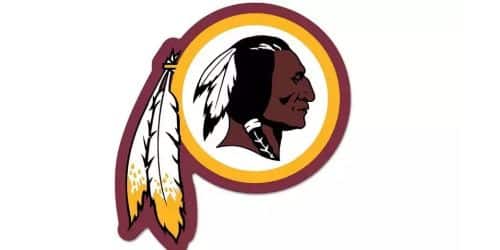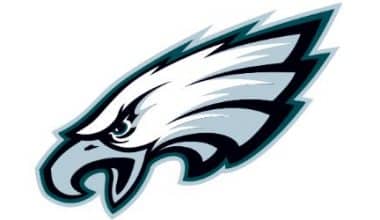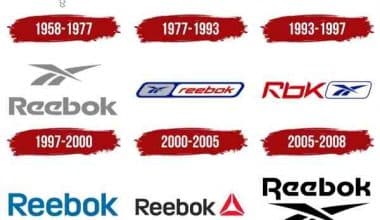The Washington Commanders, formerly known as the Washington Redskins and Washington Football Team, began in Boston on July 9, 1932, when the city was awarded an NFL franchise and took the name of their landlords, the Boston Braves. The team relocated to Fenway Park in 1933 and changed its name to the Redskins. In 1937, team owner George Preston Marshall moved the team to Washington, DC, where he grew up. That was where the team played its first season. In July 2020, the club’s original name and logo were dropped following years of outcry from critics who denounced the name as a slur used against Native Americans. In February 2022, the new logo and name of the team, the Washington Commanders, were shown to the public.
Washington Redskins Logo: Overview
The Washington Redskins are an American football team that competes in the National Football League. The squad was founded in 1932 and is a member of the NFC East Division. The club is located in the Washington, DC metropolitan area.
The franchise started with the Boston Braves. It was changed to the Boston Redskins a year after it was founded to show where it was based. The founder and original owner, George Preston Marshall, then relocated her to Washington. This occurred in 1937.
Marshall died in 1969, and Edward Bennett Williams bought a controlling stake in the club. From then until 1974, Williams was the club’s main owner. Then Jack Kent Cooke bought some of his shares, which made him an equal co-owner. This was made feasible since he already owned a 25% stake in the Washington Redskins, which he obtained through a contract with George Preston Marshall during his lifetime when he suffered a stroke and was unable to conduct business effectively.
Cooke led the club from 1985 until 1997 before establishing his foundation. Daniel Marc Snyder, who is in charge of the business now, bought a controlling share of it in 1999.
Interestingly, the Redskins are the first NFL team to have their own marching band and sports anthem (Hail to the Redskins song). Her initial name came from the baseball team of the same name, the Braves. She kept the Redskins option after moving to Washington, simply changing the location from Boston to Washington. The term “red-skinned” is seen as politically incorrect, disrespectful, and offensive, so it keeps causing problems with the name of the native Indian.
What Exactly Are the Washington Redskins?
The Washington Football Team, a member of the NFC East, was previously known as the Washington Redskins. The Washington Metropolitan Area sponsored the franchise, which was renamed in 2020. With nearly 600 victories, it is one of the National Football League’s top teams.
Washington Redskins Logo: Evolution
Although the company logo has undergone several significant alterations during its nearly 90-year history, it has always remained visually consistent with the Indian motif. The official colors of the franchise are brown, yellow, white, burgundy, and black. However, not all of them are included in every rendition of graphic symbolism.
1932
At the beginning of its sports career, the team took the logo of the Boston Red Sox. It was still in service until 1933. It depicts a red-headed indigenous representative of America wearing a traditional feather headdress. The element is created in the profile, with the profile turned to the left. White lines are used to create facial features and details. All pieces have a double edge in the base palette colors.
1933 – 1936
The insignia of this era is related to the team’s renaming as the Boston Redskins. She repeats the last rendition, but not entirely; there are some discrepancies between them. To begin, another sketching style that is close to realistic. Second, there is a yellow circle surrounding the primary piece, little strokes on the face, a white background, black hair, and two feathers. Furthermore, the Indian’s head is already twisted to the right.
1937 – 1951
Moving the franchise to Washington resulted in a revised logo for her. A yellow circle surrounds a Native American head profile. The hair is now dark brown, and there is a white garter in the braid. The feathers have changed color and are now brownish-red. The Indian’s face and neck are tanned, and he has a light reddish color, strict features, and a solemn appearance.
1952 – 1959
In 1952, the team started using a different symbolism—the most realistic portrayal of the true American folk. The yellow circle was removed by the designers, leaving a blank white space. Her hair was dyed jet black, her skin was dyed brown, and two of her feathers were dyed yellow and red.
1960 – 1964
This year’s logo is a direct homage to the original red and white design. In 1960, the club returned to the sketchy silhouette of an Indian’s head and turned to the right. There are no precise outlines in it; only broad strokes formed the face, neck, two feathers, and hair put in a bun. A red substrate was used as the background. A white border is also present.
1965 – 1969
During these years, the franchise tried to change the emblem a lot, taking out everything but the feathers from the original design. Everything else has been taken away. The end result is a simple graphic sign with a sharp spear and two feathers hanging from it. The color palette has also been altered: yellow is now utilized in conjunction with white.
1970 – 1971
Coach Vince Lombardi of the Washington Redskins insisted on a completely new logo. The team’s name is represented by a capital “R” on the logo from that time period. The sign is placed in the center of the circle on a white background. The letter itself, as well as the graphic symbol’s edge, are painted in dark crimson. The right side has two white feathers with yellow tips, which is a nod to the Native American idea.
1972 – 1981
In 1972, the club opted to restore the 1933–1936 logo and replace “R” with an indigenous figure. A yellow ring with the head of an Indian looking to the right reappeared on the logo. He has charcoal-black hair with white feathers and a dark brown complexion with a red hue. Two edging line side feathers remained unaltered.
1982
This version was created in response to a marketing demand. Because the side feathers did not fit inside the round helmet stickers, the developers “pressed” them to the ring. In addition, the Indian was rotated to the left by the designers.
1983 -Present
Because the sticker producer began using more flexible material in 1983, the feathers reverted to their dangling appearance. The current logo is mostly the same as the one from 1972, with only a few small changes.
These changes include dark gray shadows instead of black on the nose, corners of the lips, cheekbones, deepened lines on the face, and even shadows beneath the chin and neck. It also altered the skin color of a few tones. This version is being developed with the approval of Walter “Blackie” Wetzel, former president of the National Congress of American Indians.
Read Also: VISA LOGO: The History of Visa
Why Did Washington Redskins Change Logo?
The Washington Redskins naming controversy involves the Washington Commanders, a National Football League (NFL) franchise based in the Washington metropolitan region. The team’s long-standing moniker, the Redskins, and the related logo began to elicit criticism from Native American groups and people in the 1960s.
In the 1990s, the issue got a lot of attention because it was part of a bigger fight over Native American mascots. In 2020, the team will stop using its name and logo. This is because institutional racism is becoming more widely known, which is putting financial pressure on the team. Before rebranding as the Commanders in 2022, the team was known as the “Washington Football Team.”
The term “redskin” refers to Native Americans in the United States and First Nations in Canada. During the 1800s and early 1900s, the word “redskin” was used in a bad way, and modern American English dictionaries still list it as hostile, derogatory, or insulting.
For decades, the team’s owners, management, NFL commissioners, and most fans fought to keep the Redskins name. They said it was a tribute to the achievements and good qualities of Native Americans and wasn’t meant in a bad way. Bruce Allen, who was in charge of the team at the time, said that the name was used by three high schools where most of the students were Native American.
Supporters also pointed to a 2004 study by the Annenberg Public Policy Center that looked at the name across the country and found that most Native Americans didn’t find it offensive. Scholars questioned the use of public opinion polling methods to find out what a small, diverse group of people think, especially when the people who were polled chose themselves.
Name Change
During the George Floyd demonstrations in July 2020, a group of $620 billion investors issued letters to key sponsors Nike, FedEx, and PepsiCo encouraging pressure on the Redskins to change their name. FedEx called on the team to alter its name on July 2, 2020. Nike withdrew Redskins items off its website the same day.
On July 3, the league and the franchise announced that they were “undergoing a thorough review of the team name.” On July 7, it was acknowledged that the Redskins had not been in contact with a group of Native Americans who petitioned the NFL to force a name change and that Redskins head coach Ron Rivera also stated that the team wanted to continue “honoring and supporting Native Americans and our Military.”
Read Also: NISSAN LOGO: Why Did Nissan Change Its Logo (Invaluable 2022 Tips)
Jason Wright, the president of the team, said on July 12, 2021, that the new name would have nothing to do with Native Americans, including the name “Warriors.” The study has proven that anything other than a clean break from the past is a slippery slope. While the team anticipates that fans will continue to wear jerseys with the previous name and design, Native American-styled headdresses or face paint will not be permitted at the stadium.
The team declared in January 2022 that it will pick between the Armada, Presidents, Brigade, Red Hogs, Commanders, RedWolves, Defenders, and the then-current “football team.” The Washington Commanders were given a new name on February 2, 2022. In its press release, the team didn’t talk about the racial controversy. Instead, it focused on the military meaning of the elements of the redesigned “W” primary emblem that goes with the new name. The team’s history and ties to the city of Washington are both reflected in the new “crest.”
Amanda Blackhorse said that the change is meaningless because the team’s owner and management haven’t done much to acknowledge or fix the damage caused by decades of insults. They also haven’t pushed for other teams with offensive mascots to change as well.
Can You Wear Redskins Logo to the Game?
The team announced sometime in 2021 that guests will not be allowed to wear Native American apparel at FedEx Field during the 2021 season, an updated policy that comes just over a year after the franchise changed its name from “Redskins,” a term seen as a racial slur against Indigenous people in the United States.
“We are thrilled to welcome everyone back in their Burgundy & Gold,” the squad declared, referring to its traditional colors.
“However,” they added, “ceremonial headdresses or face paint with a Native American theme are no longer allowed in the stadium.”
The organization also changed some of its rules, like making fans who don’t have a COVID-19 vaccination wear masks.
Washington Redskins Logo: Font and Colors
The logos of the Washington Redskins Football Club live up to their moniker. They are either pictures of the native people of America or things that represent their cultures, like spears and feathers. The contemporary form resembles a profile portrait of an Indian. It was created in 1972, and the colors were only slightly altered in 1983. This symbol was approved by Walter “Blackie” Wetzel, who used to be president of the National Congress of American Indians.
The logo’s design is straightforward. The center features the head of a dark-skinned man with an unusual haircut and two white and black feathers. This element is set inside a white circle bordered by a yellow ring and adorned with two more feathers that are identical but have yellow edges.
Because the team’s logo contains no letters, the logo designers did not utilize the standard typeface or the Washington Redskins’ proprietary font. It only has a brown-faced Indian’s head with black hair. The dark palette is balanced with light tones of yellow and white. They create the necessary contrast so that the main character’s skin color stands out right away.
Washington Redskins Logo: Helmets
The design of the Redskins’ helmet was set in 1978 and is still used by the team. The main color of the helmet is a deep burgundy. The white, yellow, and brow symbol is positioned on the sides, with yellow, white, and burgundy stripes in the center.
Washington Redskins Logo: Uniforms
The Washington Redskins’ primary home uniform is a burgundy jersey with white numbers. Details in white and yellow adorn the shoulders. The pants are white with burgundy and yellow stripes on the sides.
The famed team’s road uniform consists of a white shirt with burgundy numbers and other tiny components, as well as bright yellow slacks with burgundy and white stripes.
History
The football team that shared the same name and playing field as the Boston Braves baseball team relocated to Fenway Park, which was already home to the Boston Red Sox, in 1933. Co-owner George Preston Marshall changed the team’s name to the Redskins. He probably did this to avoid confusion and keep the team’s Native American image, not to honor coach William Henry “Lone Star” Dietz, whose status as a Native American was questioned.
The NFL Braves logo was similar to the Redskins logo: with a Native American head in profile with braids and trailing feathers.
People who want to change the name of the team said that Native American stereotypes must be seen in the context of a history that includes conquest, forced relocation, and organized efforts by the federal and state governments to wipe out native cultures, such as boarding schools in the late 1800s and early 1900s.
Related Articles
- NATIVE AMERICAN SMALL BUSINESS GRANTS Listings In 2022 Updated!!! (The Top 15
- Industrial Insurance: Definition and Detailed Explanation
- NATIVE AMERICAN SMALL BUSINESS GRANTS Listings In 2022 Updated!!! (The Top 15)
- COMMANDERS LOGO: Meaning, Font and Leaks






